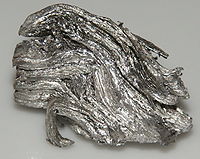
Photo from wikipedia
OBJECTIVES to compare the outcomes of using low-power (up to 30W) vs high-power (up to 120W) holmium lasers in retrograde intrarenal surgery (RIRS) in children and to analyse if lasering… Click to show full abstract
OBJECTIVES to compare the outcomes of using low-power (up to 30W) vs high-power (up to 120W) holmium lasers in retrograde intrarenal surgery (RIRS) in children and to analyse if lasering techniques and the use of access sheath have any influence on the outcomes. METHODS We retrospectively reviewed data from 9 centres of children who underwent RIRS with holmium laser for the treatment of kidney stones between January 2015 and December 2020. Patients were divided into two groups: high-power and low-power holmium laser. Clinical, perioperative variables and complications were analysed. Outcomes were compared between groups using Student's T-test for continuous variables, and Chi-square and Fisher's exact test for categorical variables. A multivariable logistic regression analysis model was also performed. RESULTS 314 patients were included. A high-power and low-power holmium laser was used in 97 and 217 patients, respectively. Clinical and demographic variables were comparable between both groups, except for stone size where the low-power group treated larger stones (mean 11.11 mm vs 9.70 mm; p 0.018). In the high-power laser group, a reduction in surgical time was found (mean 64.29 min vs 75.27 min; p 0.018) with a significantly higher stone-free rate (SFR) (mean 81.4% vs 59%; p <0.001). We found no statistical differences in complication rates. The multivariate logistic regression model showed lower SFR in the low-power holmium group, especially with larger (p = 0.011) and multiple stones (p < 0.001). CONCLUSION Our real-world pediatric multicenter study favours high-power holmium laser and establishes its safety and efficacy in children. .
Journal Title: Journal of endourology
Year Published: 2023
Link to full text (if available)
Share on Social Media: Sign Up to like & get
recommendations!